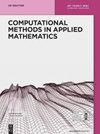Robust Finite Element Discretization and Solvers for Distributed Elliptic Optimal Control Problems
IF 1.2
4区 数学
Q3 MATHEMATICS, APPLIED
引用次数: 1
Abstract
Abstract We consider standard tracking-type, distributed elliptic optimal control problems with分布椭圆型最优控制问题的鲁棒有限元离散化及求解方法
摘要考虑具有l2 L^{2}正则化的标准跟踪型分布椭圆型最优控制问题及其有限元离散化问题。我们正在研究状态u ϱ u_{\varrho}与期望状态(目标)u¯\overline{u}在正则化参数𝜚和网格尺寸方面的有限元近似u ϱ¹h u_{\varrho h}之间的l2 L^{2}误差,从而得出最优选择ϱ =h 4 \varrho=h^{4}。事实证明,对于正则化参数的选择,我们可以设计简单的类雅可比预条件MINRES或Bramble-Pasciak CG方法,这些方法允许我们在算术操作和内存需求方面以渐进最优的复杂度解决减少的离散最优性系统。通过几个具有不同规律目标(包括不连续目标)的基准问题验证了理论结果。
本文章由计算机程序翻译,如有差异,请以英文原文为准。
求助全文
约1分钟内获得全文
求助全文
来源期刊

Computational Methods in Applied Mathematics
MATHEMATICS, APPLIED-
CiteScore
2.40
自引率
7.70%
发文量
54
期刊介绍:
The highly selective international mathematical journal Computational Methods in Applied Mathematics (CMAM) considers original mathematical contributions to computational methods and numerical analysis with applications mainly related to PDEs.
CMAM seeks to be interdisciplinary while retaining the common thread of numerical analysis, it is intended to be readily readable and meant for a wide circle of researchers in applied mathematics.
The journal is published by De Gruyter on behalf of the Institute of Mathematics of the National Academy of Science of Belarus.
 求助内容:
求助内容: 应助结果提醒方式:
应助结果提醒方式:


